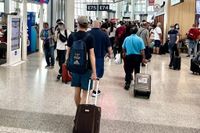It was supposed to be a routine end-of-summer travel week, but for hundreds of thousands of Air Canada passengers, August 2025 became a story of delays, stranded families, and a regulatory bottleneck that’s left many wondering if anyone is truly in charge of protecting air travelers’ rights. The three-day flight attendants’ strike may have ended, but the aftershocks are still rippling through Canada’s airports, insurance call centers, and the desks of the Canadian Transportation Agency (CTA).
According to the Canadian Press, the strike, which lasted nearly four days, grounded hundreds of flights and disrupted travel plans for approximately 500,000 customers. The operational chaos was matched only by the surge in complaints and claims that immediately followed. By August 14—just two days before the strike began—the CTA was already reporting a backlog of roughly 85,000 air travel complaints. That number did not even account for the avalanche of new grievances stemming from the strike itself.
The roots of this backlog go back to 2019, when Ottawa introduced new rules establishing compensation for flight delays, cancellations, and other disruptions. Since then, the volume of complaints has soared. In 2022–23, the CTA received about 12,000 complaints. That number skyrocketed to nearly 47,000 in the 2024–25 fiscal year, as reported by CTV News. Despite the CTA closing more than 33,600 complaints during 2024–25, the agency simply could not keep pace with the rising tide. In fact, the backlog is predicted to increase to 126,000 by 2028, with some travelers facing wait times of up to three years or more for resolution.
This mounting frustration is not lost on the CTA. Spokesperson Jadrino Huot told CTV News in an email, “This unpredictability in complaint volumes poses challenges in planning for case processing times and delivering accurate information to the public.” The agency has tried to respond by streamlining its business processes and adopting new technologies, but even with these efforts, the logjam persists.
For passengers who endured cancelled flights or lengthy delays during the strike, the process of seeking compensation can feel like a bureaucratic marathon. Under current rules, travelers must first contact the airline in writing with their claims. Only if they are unsatisfied with the response—or receive none within 30 days—can they escalate the matter to the CTA. This two-step process, critics argue, is unnecessarily complex and slow. Gabor Lukacs, president of Air Passenger Rights, called Canada’s passenger rights charter “unnecessarily and disproportionately complex,” especially when compared with Europe’s more straightforward system. He recommended that frustrated customers consider small claims court, where cases can often be resolved more swiftly.
Adding to the tension is the CTA’s proposal to charge airlines nearly $800 for each eligible complaint. Both Air Canada and WestJet have pushed back, arguing that the plan would unfairly penalize airlines even when they comply with regulations, and would ultimately burden Canadian travelers with higher costs. “Charging airlines $790 for each complaint, including the vast majority when we are found to have applied the legislation correctly, would not be balanced nor an equitable way of addressing the issue,” Air Canada said in a statement to CTV News. WestJet echoed these concerns, pointing to the already high taxes and fees in the aviation sector and warning that the proposed fee could worsen affordability for consumers during a time of economic strain.
In the immediate aftermath of the strike, Air Canada took steps to address customer grievances. The airline expanded its refund policy for affected travelers whose flights were scheduled between August 15 and 23, 2025. According to Open Jaw, the updated policy now covers not only rebooking and transport but also reasonable accommodation and out-of-pocket expenses, including hotel stays, meals, and ground transportation. Passengers must submit supporting receipts through Air Canada’s customer relations portal, but the airline cautions that given the anticipated claim volume, processing could take four to six weeks. “If Air Canada is willing to do the right thing, I would go along with the form,” Lukacs noted. “But the form is not the end of the road. The form is just the beginning of the road. It’s the easiest way possible for Air Canada to do what is required by law.”
But the strike’s impact extended beyond operational disruptions and regulatory headaches. It also exposed a widespread confusion about what travel insurance does—and does not—cover during labor disputes. Dan Keon, vice president of marketing and insights at Allianz Global Assistance Canada, told Insurance Business Canada that the disruption underscored the need for clearer communication in the insurance sector. “Airline strikes are nothing new for the industry,” he said. “This most recent strike highlights just how disruptive they can be. Given that Canada has very strong air passenger protection regulations, the responsibility for taking care of affected passengers ultimately falls with the airline.”
Keon emphasized that many travelers mistakenly believe travel insurance will make them whole after any disruption. In reality, insurance typically covers non-refundable expenses—like hotels, excursions, or connecting flights—that the airline will not reimburse. First, passengers must seek refunds or compensation from the airline. Only if there are remaining non-refundable losses will travel insurance step in. “If the airline is going to refund you, that is your first path for reimbursement,” Keon explained. “If you have non-refundable expenses, that’s where your travel insurance comes in.”
The specifics of coverage can be tricky, too. Some policies only trigger benefits once a strike is actively underway, while others may cover credible threats of labor action. Insurers use the date when a strike or threat becomes public—usually via mass media—as the cutoff for coverage. This means that travelers who purchase insurance after a strike is announced are unlikely to be covered for related disruptions. “The key is to secure your coverage at the time you book your trip, not after a potential issue has been flagged,” Keon advised. “That way, when unexpected events occur, you’re in the best position to benefit from the protection your travel insurance provides.”
For now, the system remains overwhelmed. The CTA closed more than 33,600 complaints in 2024–25, but the backlog continues to grow. The agency’s spokesperson acknowledged the challenge: “Unpredictability in complaint volumes poses challenges in planning for case processing times and delivering accurate information to the public.” Airlines, for their part, insist they are cooperating fully with regulators and striving to meet response deadlines.
For Canadian travelers, the lesson is clear: patience is required, and a thorough understanding of both airline and insurance policies is essential. The Air Canada strike may be over, but the journey to resolution—for many—has only just begun.

